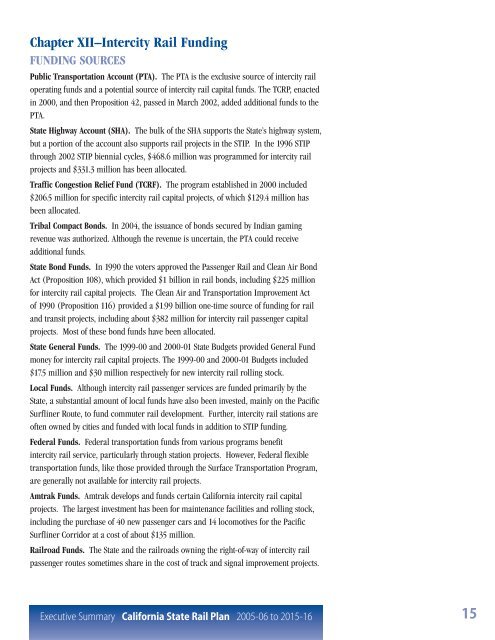California State Rail Plan 2005-06 to 2015-16
California State Rail Plan 2005-06 to 2015-16
California State Rail Plan 2005-06 to 2015-16
You also want an ePaper? Increase the reach of your titles
YUMPU automatically turns print PDFs into web optimized ePapers that Google loves.
Chapter XII–Intercity <strong>Rail</strong> Funding<br />
FUNDING SOURCES<br />
Public Transportation Account (PTA). The PTA is the exclusive source of intercity rail<br />
operating funds and a potential source of intercity rail capital funds. The TCRP, enacted<br />
in 2000, and then Proposition 42, passed in March 2002, added additional funds <strong>to</strong> the<br />
PTA.<br />
<strong>State</strong> Highway Account (SHA). The bulk of the SHA supports the <strong>State</strong>’s highway system,<br />
but a portion of the account also supports rail projects in the STIP. In the 1996 STIP<br />
through 2002 STIP biennial cycles, $468.6 million was programmed for intercity rail<br />
projects and $331.3 million has been allocated.<br />
Traffic Congestion Relief Fund (TCRF). The program established in 2000 included<br />
$2<strong>06</strong>.5 million for specific intercity rail capital projects, of which $129.4 million has<br />
been allocated.<br />
Tribal Compact Bonds. In 2004, the issuance of bonds secured by Indian gaming<br />
revenue was authorized. Although the revenue is uncertain, the PTA could receive<br />
additional funds.<br />
<strong>State</strong> Bond Funds. In 1990 the voters approved the Passenger <strong>Rail</strong> and Clean Air Bond<br />
Act (Proposition 108), which provided $1 billion in rail bonds, including $225 million<br />
for intercity rail capital projects. The Clean Air and Transportation Improvement Act<br />
of 1990 (Proposition 1<strong>16</strong>) provided a $1.99 billion one-time source of funding for rail<br />
and transit projects, including about $382 million for intercity rail passenger capital<br />
projects. Most of these bond funds have been allocated.<br />
<strong>State</strong> General Funds. The 1999-00 and 2000-01 <strong>State</strong> Budgets provided General Fund<br />
money for intercity rail capital projects. The 1999-00 and 2000-01 Budgets included<br />
$17.5 million and $30 million respectively for new intercity rail rolling s<strong>to</strong>ck.<br />
Local Funds. Although intercity rail passenger services are funded primarily by the<br />
<strong>State</strong>, a substantial amount of local funds have also been invested, mainly on the Pacific<br />
Surfliner Route, <strong>to</strong> fund commuter rail development. Further, intercity rail stations are<br />
often owned by cities and funded with local funds in addition <strong>to</strong> STIP funding.<br />
Federal Funds. Federal transportation funds from various programs benefit<br />
intercity rail service, particularly through station projects. However, Federal flexible<br />
transportation funds, like those provided through the Surface Transportation Program,<br />
are generally not available for intercity rail projects.<br />
Amtrak Funds. Amtrak develops and funds certain <strong>California</strong> intercity rail capital<br />
projects. The largest investment has been for maintenance facilities and rolling s<strong>to</strong>ck,<br />
including the purchase of 40 new passenger cars and 14 locomotives for the Pacific<br />
Surfliner Corridor at a cost of about $135 million.<br />
<strong>Rail</strong>road Funds. The <strong>State</strong> and the railroads owning the right-of-way of intercity rail<br />
passenger routes sometimes share in the cost of track and signal improvement projects.<br />
Executive Summary <strong>California</strong> <strong>State</strong> <strong>Rail</strong> <strong>Plan</strong> <strong>2005</strong>-<strong>06</strong> <strong>to</strong> <strong>2015</strong>-<strong>16</strong> 15













